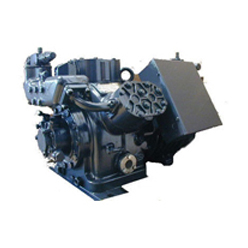Reciprocating compressors

Reciprocating compressors, or piston compressors, divided into hermetic, semi-hermetic and open, are used above all for applications with very high cooling capacity requirements. In the past these were also used in applications with very low cooling capacities due to their low costs, however they’ve progressively been replaced by rotary compressors.
These types of compressors adopt a volumetric compression system using pistons and work much like an internal combustion engine. The pistons run up and down inside cylinders, producing suction and compression of the refrigerant gas. Each cylinder has a suction valve for the gas refrigerant and a discharge valve to deliver the gas to the condenser after having been compressed.
Obviously in this case there’s no combustion stage as in the case of vehicle engines.
In general these are noisy compressors and create considerable vibrations that are felt around the entire circuit. Moreover, these are more susceptible to liquid return.
Reciprocating compressors are defined as open when one end of the crankshaft protrudes outside of the sump (the casing that houses the pistons and mechanisms inside the compressor) and can be opened. Semi-hermetic means the compressor itself and the motor are housed in the same casing, which is designed to be opened for inspection and servicing. In this case, the motor shaft and crankshaft are one single piece. Semi-hermetic compressors are made in such a way as to avoid air or dust from entering the mechanisms.
Reciprocating compressors are called hermetic when the casing is welded and sealed and the cylinder heads cannot be accessed for inspection or maintenance.
Related products and applications
| c.pCO sistema |  |
| pCO sistema |  |
| uC sistema |  |
| ir33+ platform |  |
| easy series |  |
| powersplit series |  |
| ir33 series |  |
| PowerCompact series |  |
| Cella Range |  |
| AC inverter |  |
| Chiller/Heat Pump units |  |
| Compressor Racks |  |
Do you need more informations? KNOWLEDGE CENTER
KNOWLEDGE CENTER
